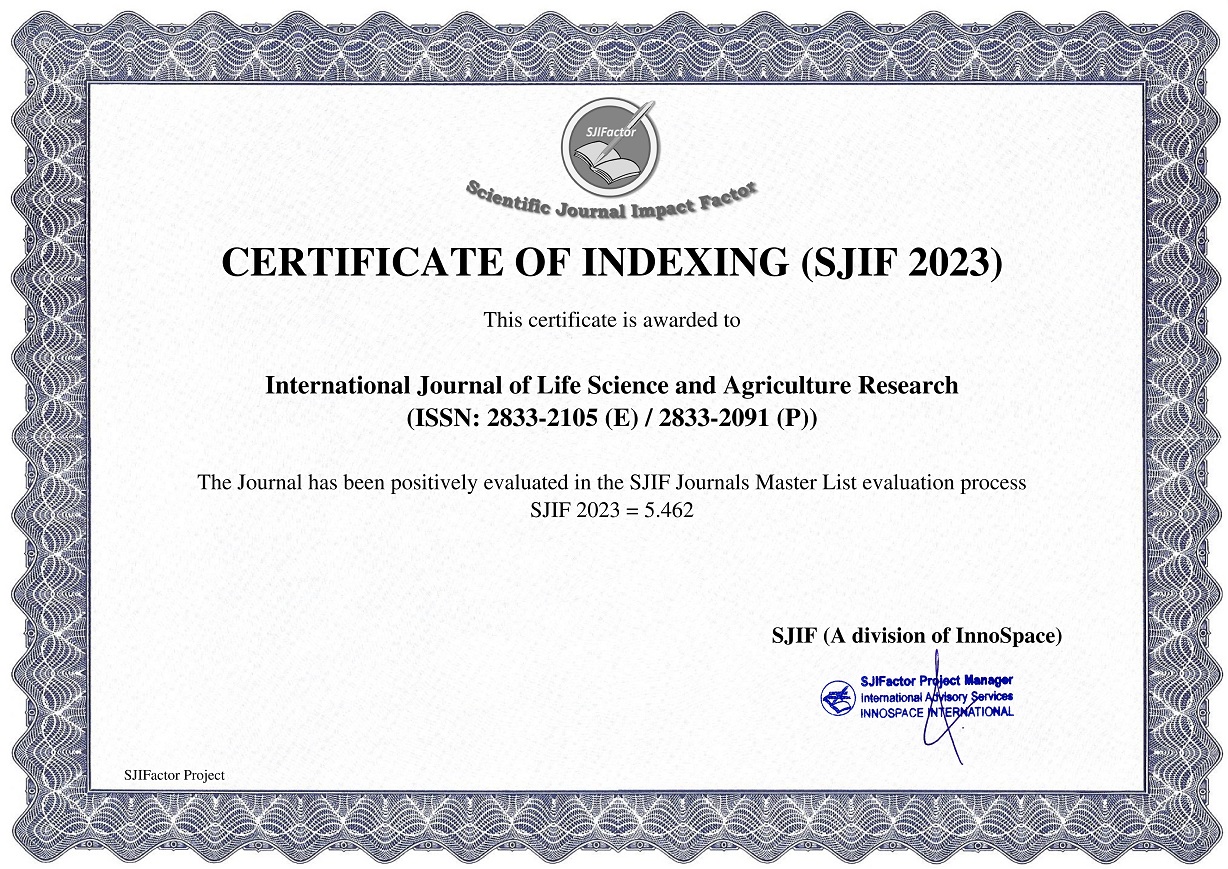Improving Salt Leaching in a Simulated Saline Soil Column by Compost and Biochar in Vietnamese Mekong Delta
DOI:
https://doi.org/10.55677/ijlsar/V02I09Y2023-01Keywords:
biochar, compost, salt-affected soil, leaching.Abstract
The problem of seawater intrusion in recent years has been serious in the coastal provinces of the Vietnamese Mekong River Delta. For rice cultivation in salt-affected areas, more effective techniques are required to remediate the saline soils for lowing salinity to secure rice growth and productivity. The objective of this study was to evaluate the potential reclamation of compost and biochar in laboratory experiment using a saline soil sample from the rice cropping system. Our hypothesis was that the addition of compost and biochar might improve the infiltration rate, resulted in more effectively salts removing from saline soil. The experiment was set up with compost and biochar at rates of 5 g kg-1, 10 g kg-1 and 20 g kg-1, respectively and 10 g kg-1 compost combined with 10 g kg-1 biochar. Soil chemical characteristics such as amount of Na+, K+, Ca2+, and Mg2+ cations removed from soil into eluent by leaching, soil availabe N, P after finishing leaching were analyzed. Results indicated that all compost and biochar amendments enhanced Na+ leaching process. This study proved that material amendment such as 20g kg-1 biochar and 10g kg-1 compost plus 10g kg-1 biochar could speed up water infiltration. Compost additions increase the available N and P content in the soil after leaching. Available N and P contents have not been improved in treatments supplemented with biochar.
References
Agbna, G.H., Dongli, S., Zhipeng, L., Elshaikh, N.A., Guangcheng, S. and Timm, L.C. 2017. Effects of deficit irrigation and biochar addition on the growth, yield, and quality of tomato. Sci. Hortic. 222, 90–101.
Ann McCauley. 2005. “Salinity & Sodicity Management”, Soil and water management Module 2. 4481 – 2 Jan. 2005, A self – study course from the MSU Extension Service Continuing Education Series.
Barnes, R.T., Gallagher, M.E., Masiello, C.A., Liu, Z., Dugan, B. 2014. Biochar-induced changes in soil hydraulic conductivity and dissolved nutrient fluxes constrained by laboratory experiments. PLoS One. 2014;9(9): e108340. Available:https://doi.org/10.1371/journal.pone.0108340.
Chen, Baoliang, Chen, Zaiming and Shaofang. 2011. A novel magnetic biochar efficiently sorbs organic pollutants and phosphate. Bioresour. Technol. 102 (2):716–723 (Elsevier Ltd.). https://doi.org/10.1016/j.biortech.2010.08.067.
De Leon-Gonzales, F., Hernandez-Serrano, M.M., Etcheveres, J.D., PayanZelaya, F. and Ordaz-Chapparro, V. 2000. Short-term compost effect on macroagregation in sandy soil under low rainfall in the valley of Mexico, Soil Till. Res. 56 (2000) 213–217.
Dominguez, R., Del Campillo, C., Pena, F., Delgado, A. 2001. Effect of soil properties and reclamation practices on phosphorus dynamics in reclaimed calcareous marsh soils from the Guadalquivir Valley, SW Spain, Arid Land Res. Manage. 15 (2001) 203–221
Drozd, J. 2003. The risk and benefits associated with utilizing composts from municipal solid waste (MSW) in Agriculture, in: J.M. Lynch, J.S. Schepers, I. Unver (Eds.), Innovative Soil-Plant Systems for Sustainable Agricultural Practices, OECD, Paris, 2003, pp. 211–226.
El-Shakweer, M.H.A., El-Sayad, E.A., Ewees, M.S.A. 1998. Soil and plant analysis as a guide for interpretation of the improvement efficiency of organic conditioners added to different soil in Egypt. Comm. Soil Sci. Plant Anal. 29, 2067–2088.
Engelstad, O.P. and Terman, G.L. 1991. Agronomic effectiveness of phosphate fertilizer, in: F.E. Khasawneh, E.C. Sample, E.J. Kamprath (Eds.), The Role of Phosphorus in Agriculture, American Society of Agronomy, Madison, Wisconsin, USA, 1980.
Gupta, R.K. and Abrol, I. 1990. Salt-affected soils: their reclamation and management for crop production. Adv. Soil Sci.Springer, pp. 223–288.
Hidayat, A. 1978. Methods of Soil Chemical Analysis. JICA. Central Research Institut for Agricultural. Bogor. Indonesia. pp 30-39.
Hopkins, B. and Ellsworth, J. 2005. Phosphorus availability with alkaline/calcareous soil, in: Western Nutrient Management Conference, vol. 6, Salt Lake City, UT, 2005.
Jien, S.H. and Wang, C.S. 2013. Effects of biochar on soil properties and erosion potential in a highly weathered soil. Catena 110:225–233.
Joseph, S., Husson, O., Graber, E.R., van Zwieten, L., Taherymoosavi, S., Thomas, T. and Nielsen, S. 2015. The electrochemical properties of biochars and how they affect soil redox properties and processes. Agronomy 5:322–340. https://doi.org/10.3390/agronomy5030322
Laird, D.A., Fleming, P., Davis, D.D., Horton, R., Wang, B.Q. and Larlen, D.L. 2010. Impact of biochar amendments on the quality of a typical Midwestern agricultural soil. Geoderma 158:443–449.
Lakhdar, A., Hafsi, C., Rabhi, M., Debez, A., Montemuro, F., Abdelly, C., Jedidi., N. and Ouerghi, Z. 2008. Application of municipal solid waste compost reduces the negative effects of saline water in Hordeum maritimum L., Bioresour. Technol. 99 (2008) 7160–7167.
Lehmann, J. and Joseph, S., 2009. Biochar for environmental management: An introduction. Biochar for Environmental Management. Science and Technology, 1-12. London: Earthscan.
Liang, Y., Si, J., Nikolic, M., Peng, Y., Chen, W., Jiang, Y. 2005. Organic manure stimulates biological activity and barley growth in soil subject to secondary salinization. Soil Biol. Biochem. 37 (6), 1185–1195.
Muhammad, S., Muller T. and Georg Joergensen, R. 2007. Compost and Pamendments for stimulating microorganisms and maize growth in a saline soil from Pakistan in comparison with a nonsaline soil from Germany, J. Plant Nutr. Soil Sci 170, 745-751.
Muneer, M. and Oades, J.M. 1989. The role of Ca-organic interactions in soil aggregate stability. II. Field studies with 14C-labelled straw, CaCO3 and CaSO4.2H2O. Aust J Soil Res 27:401–409.
Nelson, P.N. and Oades, J. M. 1998. Organic matter, sodicity and soil structure. In: Sumner, M.E., and Naidu, R., (eds.) Sodic soils: distribution, properties, management and environmental consequences. Topics in Sustainable Agronomy. Oxford University Press, New York, USA, pp. 51-75.
Olk, D.C. and Cassman, K.G. 2002. The role of organic matter quality in nitrogen cycling and yield trends in intensively cropped paddy soils. In the 17th World Congress Soil Science, 14-21 August 2002. Thailand. Paper no: 1355.
Olsen, S.R., Cole, C.V., Watanabe, F.S. and Dean. L.A. 1954. Estimation of available phosphorus in soils by extraction with sodium bicarbonate. USDA Circular 939. U.S. Government Printing Office, Washington D.C.
Ouyang, L., Wang, F., Tang, J., Yu, L., Zhang, R. 2013. Effects of biochar amendment on soil aggregates and hydraulic properties. Journal of Soil Science and Plant Nutrition 13:991-1002.
Phuong, N.T.K., Khoi, C.M., Sinh, N.V., Chiem, N.H., Toyota, K. 2019. Effects of rice husk biochar and calcium amendment on remediation of saline soil from rice‐shrimp cropping system in vietnamese mekong delta. JEAI 2019, 39, 1–12, doi:10.9734/jeai/2019/v39i230327.
Ros, M., Hernandez, M.T. and García, C. 2003. Soil microbial activity after restoration of a semiarid soil by organic amendments. Soil Biol. Biochem. 35 (3), 463–469.
Sanyal, S.K., De Datta, S.K. 1991. Chemistry of phosphorus transformations in soil, Adv. Soil Sci. 16 (1991) 1–120.
Sekhar, D.M.R. and Aery, N.C. 2001. Phosphate rock with farmyard manure as P fertilizer in neutral and weakly alkaline soils, Curr. Sci. 80 (2001) 1113–1115.
Shepherd, Jessica, Joseph, Stephen, Sohi, Saran, Heal, Kate. 2017. Biochar and Enhanced Phosphate Capture: Mapping Mechanisms to Functional Properties. Chemosphere Vol. 179:pp. 57–74 (Elsevier Ltd.). https://doi.org/10.1016/j.
chemosphere.2017.02.123
Tejada, M., Garcia, C., Gonzalez, J.L. and Hernandez, M.T. 2006. Use of organic amendment as a strategy for saline soil remediation: influence on the physical, chemical and biological properties of soil. Soil Biol. Biochem. 38 (6), 1413–1421.
Tejada, M., Gonzalez, J.L., Garcia-Martinez, A.M. and Parrado, J. 2008. Effects of different green manures on soil biological properties and maize yield, Bioresour. Technol. 99 (2008) 1758–1767.
Tejada, M., Hernandez, M. and Garcia, C. 2009. Soil restoration using composted plant residues: effects on soil properties. Soil Till. Res. 102 (1), 109–117.
Thanh, N.C. 2016. Saltwater intrusion - An evident impact of climate change in the MD and propose adaptable solutions. American Journal of Environmental and Resource Economics. 1(1): 1-8.
Walker, D.J. and Bernal, M.P. 2008. The effects of olive mill waste compost and poultry manure on the availability and plant uptake of nutrients in a highly saline soil. Biores. Tech. 99 (2), 396–403.
Warrence, N.J., Pearson K.E. and Bauder., J.W. 2003. The basics of salinity and sodicity effects on soil physical properties, Montana state university.
Weber, J., Karczewska, A., Drozd, J., Licznar, M., Licznar, S., Jamroz, E. and Kocowicz, A. 2007. Agricultural and ecological aspects of a sandy soil as affected by the application of municipal solid waste composts, Soil Biol. Biochem. 39 (2007) 1294–1302
Wong, V.N.L., Greene, R.S.B., Dalal, R.C. and Murphy, B.W. 2010. Soil carbon dynamics in saline and sodic soils: a review. Soil UseManage 26:2–11.
Yao, Ying, Gao, Bin, Chen, Jianjun, Yang and Liuyan. 2013. Engineered biochar reclaiming phosphate from aqueous solutions: mechanisms and potential application as a slow-release fertilizer. Environ. Sci. Technol. 47:8700–8708. https://doi.org/10.1021/es4012977
Yue, Y., Guo, W., Lin, Q., Li, G. and Zhao, X. 2016. Improving salt leaching in a simulated saline soil column by three biochars derived from rice straw (Oryza sativa L.), sunflower straw (Helianthus annuus), and cow manure. Journal of Soil and Water Conservation. 2016;71(6):467-475. DOI: 10.2489/jswc.71.6.467.





